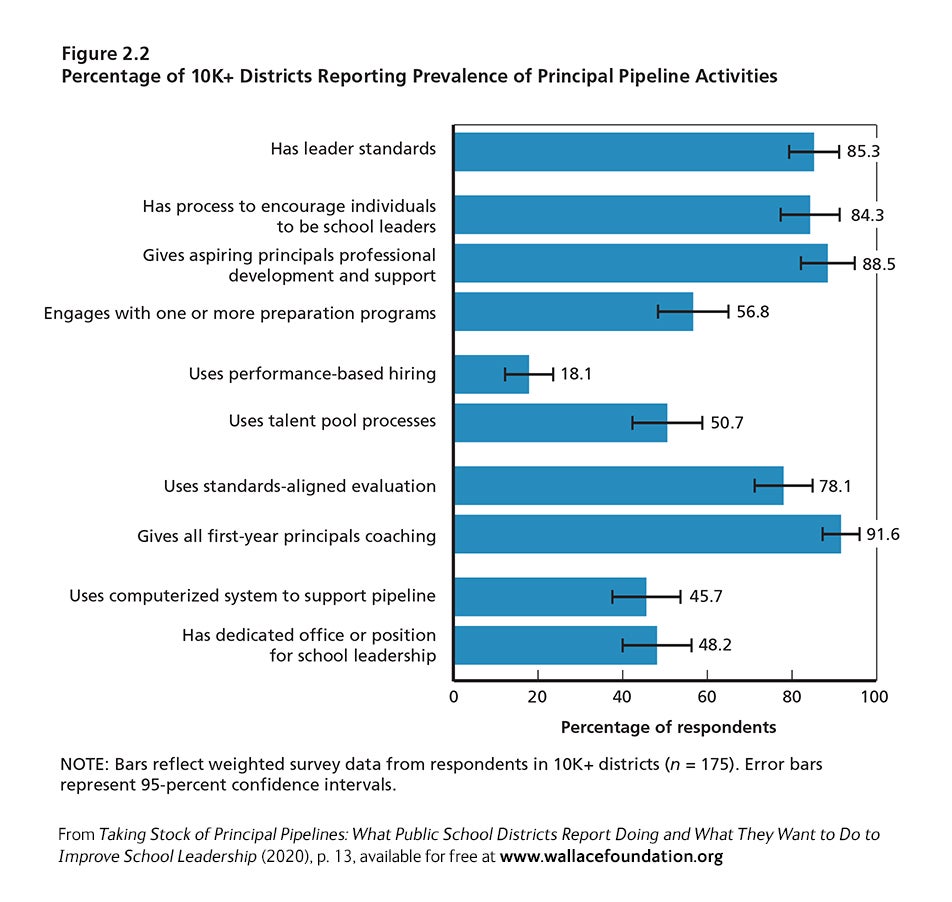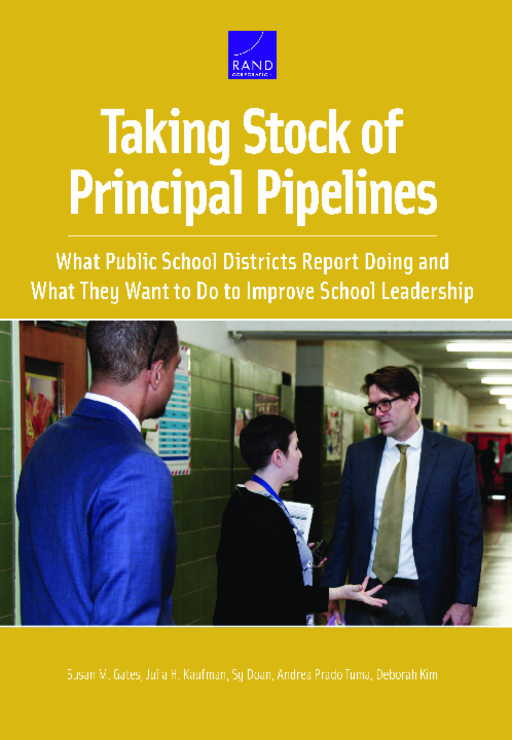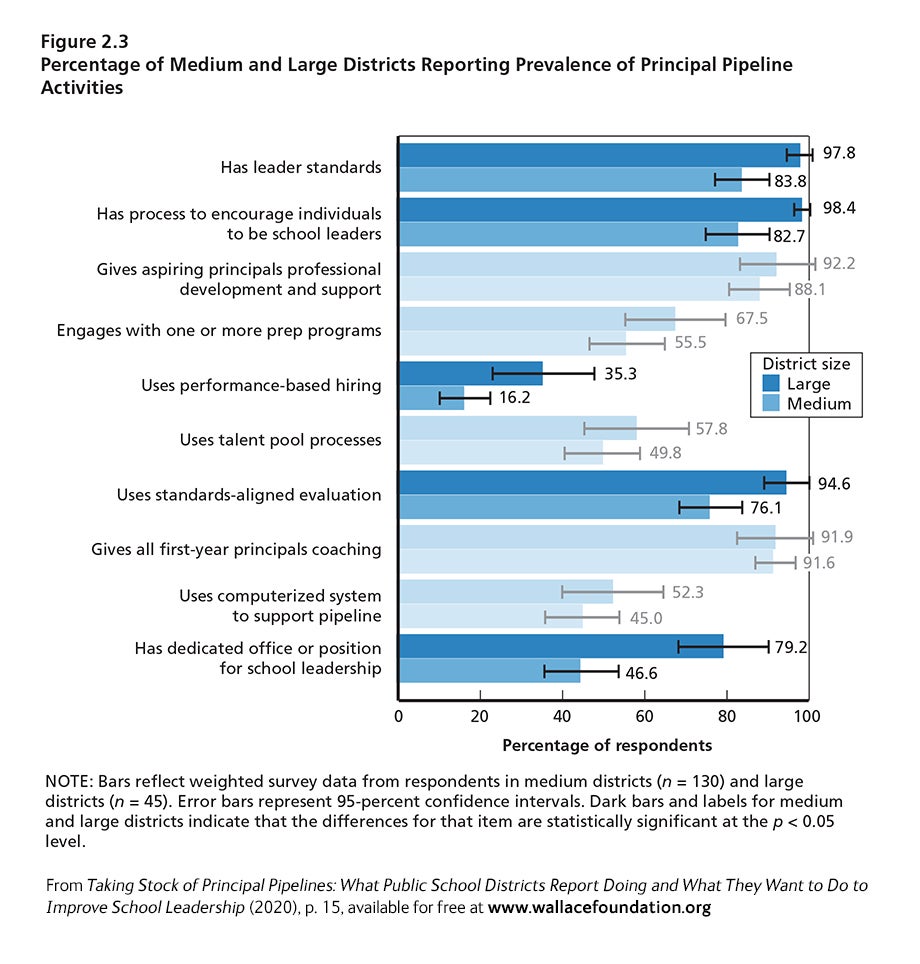
Breadcrumb
- Wallace
- Reports
- Taking Stock Of Principal Pipeli...
Taking Stock of Principal Pipelines
What Public School Districts Report Doing and What They Want to Do to Improve School Leadership

- Author(s)
- Susan M. Gates, Julia H. Kaufman, Sy Doan, Andrea Prado Tuma, and Deborah Kim
- Publisher(s)
- RAND Corporation
- DOI Link
- https://doi.org/10.7249/RRA274-1
Summary
How we did this
Researchers interviewed a nationally representative sample of large and medium sized districts. They followed a structured interview protocol and then analyzed the results.
Leaders of large and medium-size school districts overwhelmingly view good principals as essential to school improvement. Yet about only half are satisfied with the candidates in their principal pipelines. This finding suggests that the “pipeline” for preparing, hiring, and supporting new principals could be improved.
That’s one takeaway from this first-of-its-kind study. Researchers interviewed a nationally representative sample of superintendents and other top administrators from large and medium-size school districts. They wanted to find out the degree to which districts use elements found in effective principal pipelines.
The survey is based on a groundbreaking 2019 report by RAND. That report studied six large school districts that built strong principal pipelines with funding from The Wallace Foundation. The benefits for students were notable. Pipeline-district schools with newly placed principals outperformed comparison schools in reading and math. The study identified practices that made the pipelines effective.
This follow-up survey was intended to see how widespread these pipeline practices were in districts serving more than 10,000 students. The survey found that:
- 90 percent of district leaders said that their district goals, plans, or initiatives tied school leadership to school improvement
- Yet only 49 percent were either satisfied or very satisfied with the principal candidate pool. Respondents most often cited a lack of candidates from specific ethnic groups, with leadership experience, and with particular leadership skills.
What Most Districts Did Right
Districts reported having many elements of strong principal pipelines in place:
- More than three quarters of districts reported having:
- school leader standards
- processes to encourage individuals to be school leaders
- professional development and support for aspiring principals
- standards-aligned evaluation (when they had standards)
- coaching for all first-year principals
- About half of districts reported actively engaging with at least one principal preparation program
- All districts had someone responsible for supervising principals
What Was Missing
Some practices were less common.
- Less than half of districts had a position or office dedicated to school leadership.
- Less than half had a computerized system for tracking data on school leaders.
- Very few districts (only 18 percent) used performance tasks to assess candidates for a principal spot.
- Less than 60 percent were engaging with principal preparation programs.
- Overall, medium-size districts were less likely to report engaging in pipeline activities than large districts (with at least 50,000 students).
Large majorities in both large and medium-size districts showed interest in strengthening their pipelines. Some areas they most wanted to strengthen were:
- Leader standards
- Principal preparation
- Hiring and placement
- On-the-job evaluation and support
The biggest obstacles to undertaking this work? Time and funding, district leaders said.
Smaller Districts Also Interviewed
The researchers also interviewed officials in 17 districts having fewer than 10,000 students. That sample was not large enough to be representative of the 12,000 or so small districts nationally. But the interviews suggest areas for future study. This is important because small districts serve about 45 percent of public school students in the U.S.
Responses showed some similarity with responses from the larger districts. All small district leaders agreed that school leadership was tied to school improvement. Most said their districts had a number of pipeline elements including leader standards. Most also engaged one with at least one pre-service principal preparation program. The majority offered coaching for first-year principals.
Key Takeways
- District leaders overwhelmingly linked school leadership to school improvement. Yet only 49 percent were either satisfied or very satisfied with the principal candidate pool. This suggests their “pipeline” for preparing, hiring, and supporting new principals could be improved.
- A 2019 RAND study demonstrated that strong principal pipelines led to significant student benefits in math and reading. The districts interviewed in this survey had many elements found in effective principal pipelines. All had someone supervising principals. More than three quarters had: 1) school leader standards; 2) processes to encourage individuals to be school leaders; 3) professional development and support for aspiring principals; 4) standards-aligned evaluation (when they had standards); 5) coaching for all first-year principals.
- Some practices were less common. Less than half had a computerized system for tracking data on school leaders. Very few districts used performance tasks in hiring principals.
- Overall, medium-size districts were less likely to report engaging in pipeline activities than large districts.
- Large majorities in both large and medium-size districts showed interest in strengthening their pipelines.
Materials & Downloads
What We Don't Know
- How prevalent are principal pipeline elements in districts enrolling fewer than 10,000 students?
- What programs or approaches can boost on-the-job support and evaluation of principals?
- How can preparation programs and state agencies that oversee them foster collaboration between programs and districts, including small districts?


